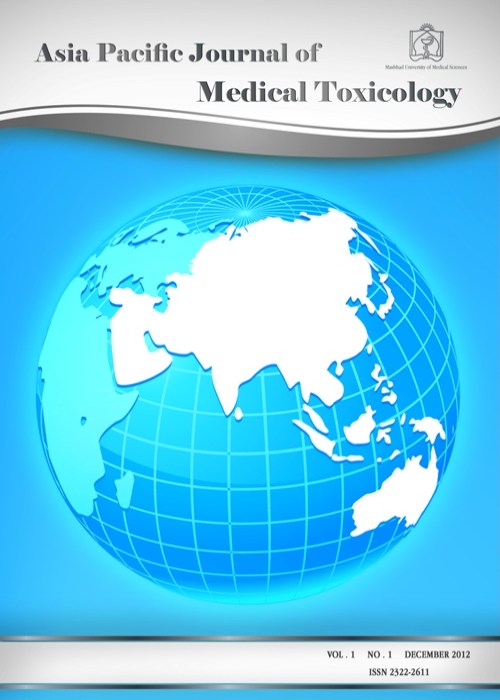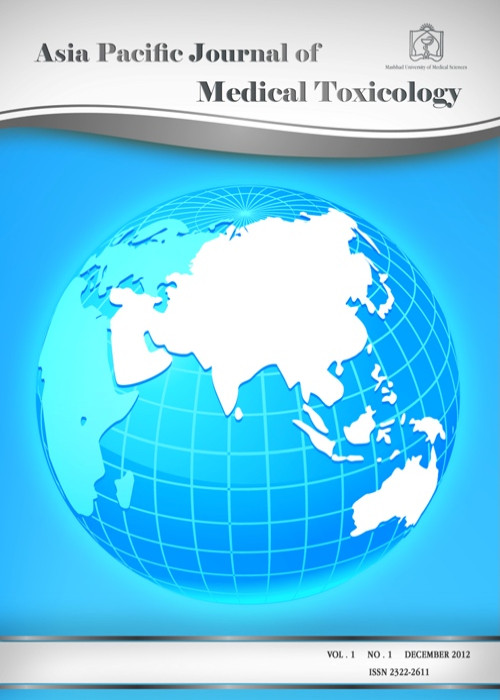فهرست مطالب

Asia Pacific Journal of Medical Toxicology
Volume:12 Issue: 2, Spring 2023
- تاریخ انتشار: 1402/04/10
- تعداد عناوین: 8
-
-
Pages 42-48BackgroundPoisoning remains one of the health problems that causes significant patient mortality and morbidity worldwide regardless of a country's development or culture. It can occur secondary to exposure to natural ingredient or chemical substance.MethodsThis study was conducted to evaluate Alexandria Poison Center (APC) data for trends and modes of poisoning exposure over a 5-year period and to evaluate the characteristics of human exposure based on the cases received by APC. The data was collected retrospectively from 1st of January 2017 to 31st of December 2021 and all patients admitted through this time (36853 cases) were included.ResultsThe study revealed that poisoning occurs significantly more in females than males and the highest incidence of poisoning occurred in adult category. Pesticides were accountable for the highest number of poisoning cases; also, pesticides were responsible for more than 70% of deaths. So, Pesticides were selected as a model to be analyzed in detail. On the side of the study, the effect of COVID-19 was studied and revealed no significant changes in profile of acute poisoning cases, however, suicidal tendency remarkably increased in 2020 and 2021 in comparison to other studied years.Keywords: Acute poisoning, Pesticides, Poisoning, Alexandria
-
Pages 49-53BackgroundScorpion sting is one of the medical health problems in tropical and subtropical regions of Iran. This study deals with the frequency of complications of scorpion sting, in patients referred to Afzalipour Hospital in Kerman.MethodsThis retrospective descriptive-analytical study was performed using the census sampling method of patients, who referred to Afzalipour Hospital in Kerman following scorpion sting. The statistical population included all patients from 2016 to 2018. After collecting and extracting the data, the results were analyzed by SPSS software.ResultsA total of 111 stings were reported, 61 females (55%) and 49 males (45%). Local signs included pain (55), swelling (15.3), erythema (21.6), skin ecchymosis (18.9), tenderness (10.8), and bleeding (1.8%). Systemic symptoms included nausea and vomiting (9), pain (1.8), numbness and paresthesia (3.6), weakness (9) and (86.5) without systemic symptoms. The average number of hospitalization days was 1.77.ConclusionClinical manifestations of patients show that species belonging to two families, Buthidae and Hemiscorpidae, are the cause of stings in this province. Stings has been more common in women and in the age group of 21 to 40 years old and more in July. Due to different species with neurotoxic and hemotoxic poison, the development of treatment protocols by trained physicians, who are familiar with clinical manifestations of these arthropods, are essential.Keywords: Scorpion sting, Pain, Burning, Swelling, clinical complications
-
Pages 54-59IntroductionAluminum phosphide (AlP) poisoning, commonly known as rice tablet poisoning, is a lethal method of suicide with no known antidotes. Thyroid hormones have inotropic effects that can potentially reverse hemodynamic instability and improve cardiac output. This study investigated the effects of Triiodothyronine (T3) on the cardiac function of patients with aluminum phosphide poisoning.MethodsIn this randomized clinical trial, 24 patients with confirmed ALP poisoning were recruited. The intervention group received T3 treatment in addition to standard treatment, while the control group received only standard treatment. Demographic variables, cardiac parameters, biochemical markers, and oxidative stress tests were evaluated.ResultsThe majority of participants were men (60%) in their thirties (intervention: 32±17.4 years; control: 30±11.6 years). Following treatment, both systolic and diastolic blood pressures had significantly higher mean differences in the T3 group compared to the control group (18.7±9.3, P=0.05 and 14.1±5.9, P=0.03 respectively). While both groups showed improvement in mean arterial pH, the intervention group exhibited a significantly greater improvement 12 hours after the administration of T3, which was significantly different from both the baseline and control groups (p=0.04, 0.009 respectively). Additionally, the intervention group had a lower QRS and QTc interval compared to admission time.ConclusionTriiodothyronine administration has been shown to maintain a higher range of SBP, control cardiogenic shock, regulate metabolism, improve acidosis and blood pressure, and ultimately enhance recovery in patients with aluminum phosphide poisoning. Furthermore, it may have cardio-protective effects on these patients.Keywords: Aluminum phosphide, Phosphine, Poisoning, Triiodothyronine
-
Pages 60-65BackgroundNicotine is a potential cause of male infertility due to its ability to induce testicular damage. This study investigated the influence of Basella Alba (BA) on possible nicotine-induced testicular damage.MethodsTwenty male Wistar rats were divided into four random groups namely; healthy control (HC) in which rats were administered only normal saline, Nicotine control (NC) which received high dose nicotine only (1.0mg/kg), Low dose nicotine, Basella Alba treatment group (LDN + BA) given nicotine (0.5mg/kg) plus methanol extract of Basella Alba (200mg/kg) and High dose nicotine, Basella Alba treatment group (HDN + BA) in which rats received nicotine (1.0mg/kg) plus Basella Alba extract (200mg/kg). Rats were euthanized via exsanguination after five weeks of treatment and testes extracted for histological analysis. Blood samples were also analyzed for gonadal hormones.ResultsThere was a significant decline (p<0.05) in body weight, testicular weight, and serum testosterone but elevated follicle stimulating hormone (FSH) and luteinizing hormone (LH) in NC rats when compared with HC. Rats in LDN + BA and HDN + BA showed a significant increase (p<0.05) in serum testosterone and a corresponding decrease (p<0.05) in FSH and LH levels when compared to rats in NC. Additionally, testicular photomicrographs revealed significant histoarchitectural distortions in NC rats when compared to HC. These anomalies were found to be either milder or absent in LDN + BA and HDN + BA groups.ConclusionsNicotine induces both structural and functional testicular damage that is ameliorated by Basella Alba possibly due to the high antioxidant composition.Keywords: Oral, Methanol, Nicotine, Testis, Toxicity
-
Pages 66-71Background
COVID-19 pandemic associates with many acute and long-term effects. Hyperglycemia and diabetes are among the common comorbidities that negatively affect the outcome of COVID-19 patients. Many studies report an increase in the incidence of new-onset diabetes and diabetic ketoacidosis during the pandemic of COVID-19. Aim of the Study: This review article aimed to study the bidirectional relationship between diabetes and COVID-19 and understand the possible underlying mechanisms predisposed to diabetes in patients with COVID-19.
MethodsThe present work performs an online literature search on databases from PubMed, Google Scholar, Scopus, ResearchGate, and Web of Science. The search includes publications on SARS-CoV-2 or COVID-19, hyperglycemia, diabetes, and diabetic ketoacidosis.
ResultsThere is a slight increase in the incidence of hyperglycemia and new-onset diabetes during or post COVID-19 infections. Among the proposed mechanisms of that increase are the direct and indirect effects of SARS-CoV-2 on Beta cells of the pancreas. These effects arise from viral-mediated inflammatory and immunological effects on Beta cells. Stress hyperglycemia, corticosteroid administration, obesity, and preexisting diabetes are important aggravating factors for developing diabetes in COVID-19 patients.
ConclusionThe long-term follow-up is mandatory to determine the outcome of patients, who develop new-onset diabetes after COVID-19 infection.
Keywords: COVID-19, Diabetes, Diabetic Ketoacidosis, Hyperglycemia -
Pages 72-73Background
Venom ophthalmia (VO) is caused by inoculation of venom in the eyes. In Singapore, the spitting cobra is associated with VO. We present 2 cases of VO treated with topical heparin despite not proven for clinical use.
Case Report:
Our first patient was spat by a spitting cobra in his eye while working and complained of throbbing pain and blurring of vision. He irrigated his eyes with drinking water before attending the Emergency Department (ED). His pain and vision minimally improved despite irrigation with normal saline. 1ml of unfractionated Heparin (UFH) resulted in improvement of pain.Our second patient was spat by a spitting cobra in his right eye, had right eye pain and tearing. He had irrigated the eye with water before coming to the ED. In ED, his eye was irrigated with 9.5L of normal saline followed by 1 ml of UFH.Both were reviewed by Ophthalmology and showed punctate epithelial erosions (PEE), which resolved 2 weeks after for the first patient. Unfortunately, the second patient defaulted his follow up. However, none showed immediate side effect after UFH.
DiscussionMultiple anterior segment complications have been reported in cases of VO. Copious irrigation of the eyes with water or saline is single most important step in management. Heparin has not been described to be a part of standard treatment protocol.
ConclusionTopical heparin drops may safely be used in cases of VO, where traditional irrigation methods do not result in improvement in symptoms.
Keywords: Spitting Cobra, Naja Sumatrana, Topical Heparin -
Pages 74-76Background
Litarge (Lead II oxide) is named Murder-sang, Murdar Singh or Mordab-Sangh (MS) in person, is applied to reduce body odor in the axillary and legs. Several other indications were mentioned in ancient medicine such as syphilitic chancre wound healing, bed sore, and so forth. We reported lead intoxication by eating a few MS.
Case:
A 34-year-old man was visited due to accidentally consuming his wife’s MS powder by adding to his food instead of spices, 10 days earlier. He experienced acute abdominal pain and non-bloody diarrhea 6 hours after ingestion. His symptoms were finally treated by supportive therapy despite their persisted. Ten days later, his blood lead level was 1250 µg/L. His hemoglobin level reduced and transaminase raised to 1.5 times more than the upper limit. He was treated with oral Succimer 10 mg/kg three times a day in the first 5 days and continued by 10mg/kg twice a day up to 21 days. On the 5th day of treatment, his symptoms improved. His blood lead level was 545.5 µg/L on the 8th day of treatment and reduced to 254 µg/L and 245 µg/L one and two months later.
DiscussionMordab-Sangh could induce lead toxicity if ingested. However, other metal poisoning should be considered in MS ingestion
Keywords: lead poisoning, Heavy Metal Poisoning, Diarrhea, Chelation therapy -
Pages 77-80Introduction
Pendimethalin is an herbicide that is used worldwide to attack certain wide leaf and grassy weeds in a variety of agricultural and non-crop regions, with a claimed very low toxicity to human. There have been some few reported cases of acute pendimethalin toxicity to date, around the world. We report a case of pendimethalin toxicity resembling and managed initially as organophosphorus poisoning.
Case Description:
A 42-year-old agricultural worker was found unresponsive in his field with profuse oral secretions. The patient presented with altered mental status, where Glasgow comma scale was 10, oxygen saturation at room air was 88 %, Blood pressure measured 125/75, pulse rate was 95 beats per minute, and temperature was 37 °C. The patient’s pupils were constricted, equal, regular, and reactive. Chest examination revealed scattered respiratory crepitations. The patient also had a distinct garlic odor very similar to that of Organophosphate compounds. The results of his laboratory investigations revealed only hypoxemia. The patient received atropine and supportive management, which prompted the chest secretions to clear up and allow him to restore consciousness without experiencing any neurological problems.
ConclusionPendimethalin toxicity can present with manifestations mimicking acute organophosphorus poisoning. Proper supportive care is needed for the management of acute pendimethalin toxicity.
Keywords: Pendimethalin, Herbicide, acute toxicity, Organophosphorus mimic, Agricultural worker


